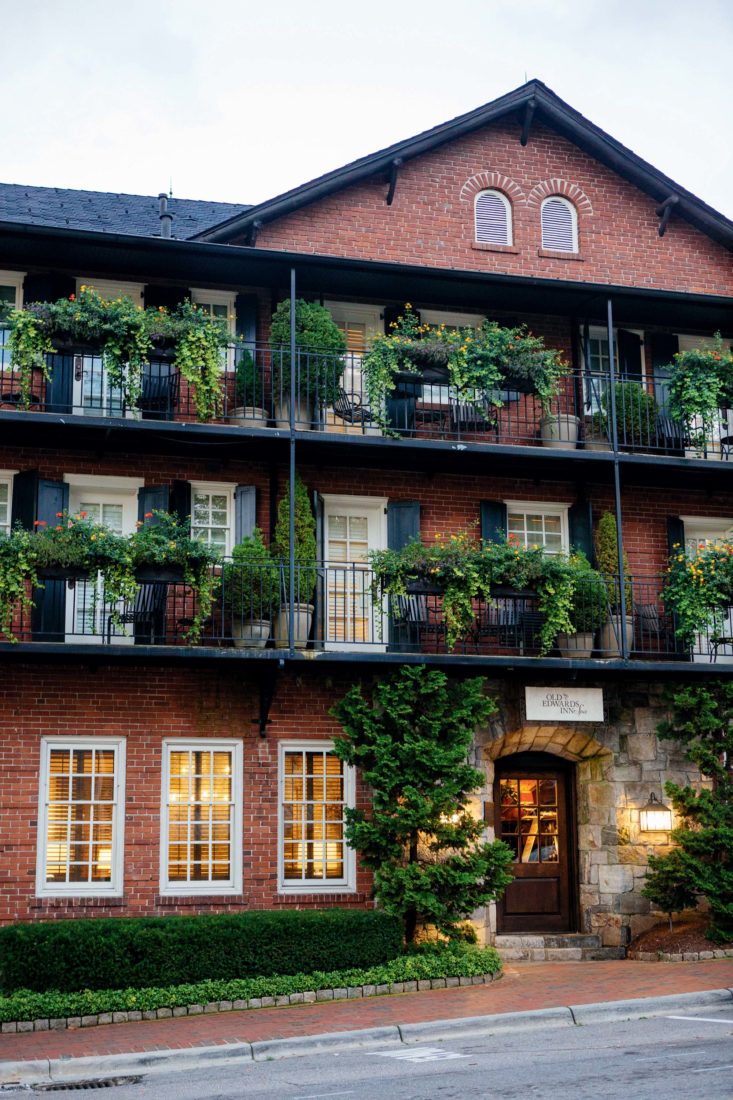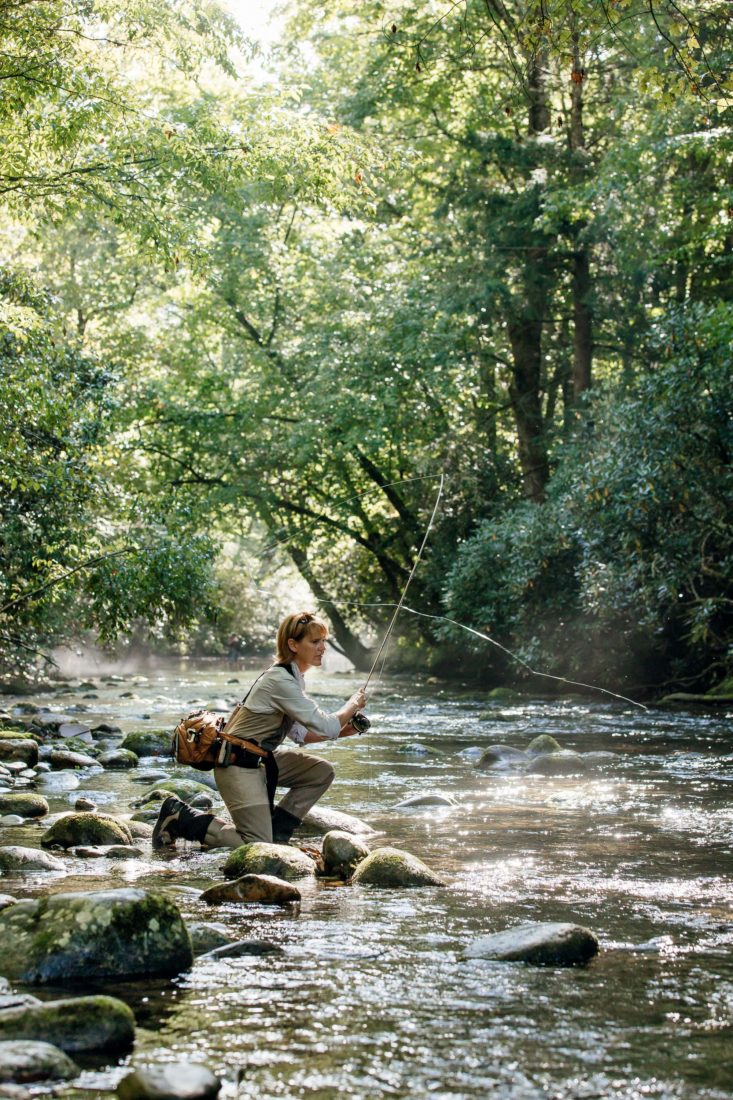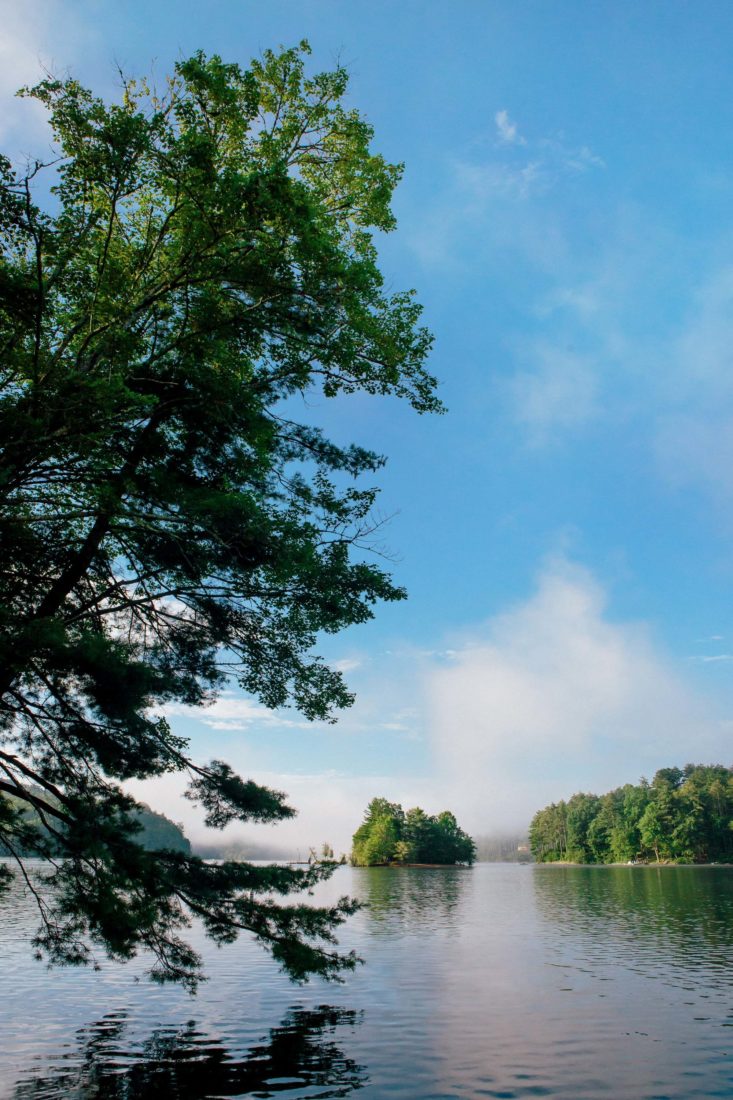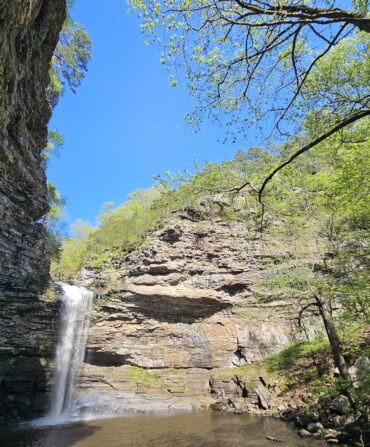I hadn’t been beyond my zip code in months, it was ninety-six degrees outside, and a pandemic gripped the land. So imagine my thrill as I rolled away from my home in Clemson, South Carolina, and into the North Carolina mountains, the temperature dropping with every mile, rivers flashing up between pines, and no other humans in sight. I was so giddy I literally dialed up some John Denver. But as I pulled into the parking lot at the Whiteside Mountain trail, my heart broke a little when I saw cars filling every spot. I wasn’t the only one in need of an escape. Luckily, a friend had given me a tip about a lesser-known trail, one she promised was “a lot of candy for the nickel,” so I changed course for Satulah Mountain, taking me through downtown Highlands.

Even though this mountain hamlet is tiny—population 989—Highlands’ Main Street is downright cosmopolitan. Anchored by the historic Old Edwards Inn and lined with boutiques, restaurants, and outfitters (like Highland Hiker, a go-to for outdoor gear), the center of town was bustling. I rolled past it all, though, and parked at the base of Satulah Road, where I walked up through a beautiful historic district with stately cedar-shingle houses rising out of swells of hostas and hydrangeas, all buttressed by lichen-covered stonework. I saw a grand total of zero people as I made my way, but after a mile or so I started to wonder if this could be right. Then the road ended and a trail marker appeared within some rhododendrons, which I followed until I emerged onto a stone outcropping with a panoramic view of the Blue Ridge Mountains so spectacular I burst into laughter.

This stretch of the Western North Carolina mountains—running through Highlands, Cashiers, and Brevard along U.S. Route 64—is full of surprises. Textured with fern-covered rock, blossoming mountain laurel, and rivers filled with trout dashing between sun-dappled stones, its natural bounty is intoxicating. And while less developed than nearby hot spot Asheville, it still boasts world-class cultural offerings. The Brevard Music Center hosts one of the country’s top classical music summer festivals, the six-acre Bascom center for the visual arts in Highlands maintains a wide variety of rotating exhibitions, and the annual Highlands Food & Wine Festival in November brings not only celebrity chefs to town, but also stellar musical acts (Mandolin Orange and St. Paul and the Broken Bones are both slated for this year’s fest).

At the moment, though, the fact that the elevation had made the temperature fall sixteen degrees was the region’s most beguiling asset of all, so I rolled down my windows and headed toward Half-Mile Farm, an apple orchard and farm turned lavish country inn.

“We do have a swimming pool,” the receptionist said as I ogled the glittering pond through the window. Tucked into a lush garden beside Half-Mile’s historic farmhouse, the pool was wildly inviting for sure, but I’d made up my mind that this trip was going to be all about wide-open spaces. After dropping my bags in my room, which included not only a fireplace and a four-poster bed, but also a bathtub the size of a kiddie pool and a private balcony overlooking a mountain ravine, I dashed back out toward the pond.

Built in the late 1800s, Half-Mile Farm began operating as a boardinghouse in the early 1900s. The Old Edwards group purchased it in 2015, added a twelve-room wing to the original farmhouse, and maintains three lovely cabins on the site. “We did spend a penny,” said Old Edwards general manager Jack Austin, of the inn’s extensive renovation. “In fact, we spent a lot of them.”
I passed beneath a trellis of grapevines, took stone steps up a bank of wildflowers, and walked onto the lawn. It was as if I’d arrived at a luxury summer camp. White Adirondack chairs circled a firepit. In the distance, through a fringe of lilies, a couple cast fishing lines into the pond. Two red canoes rested on the bank. I ran past it all and jumped off the dock.
The next morning, I picked up breakfast at Mountain Fresh Grocery in Highlands, where as many dogs as people populated the picnic tables out front, and with biscuit in hand, I drove ten miles east to the heart of Cashiers—the intersection of Highways 64 and 107. Here the bustling Cashiers Farmers Market sits across the street from Buck’s Coffee Cafe, and nearby, Slab Town Pizza serves handmade pies and Sugar Cloud Baking Company makes from-scratch doughnuts. Two miles south stands the storied Inn at High Hampton, with its wraparound porches and wood-paneled interior straight out of some mountain dream. But I’d come to Cashiers for Brookings Anglers.

The area’s premier fly-fishing outfitter features a strong roster of guides, and one of their finest, Simons Welter, was waiting on the front stairs for me. The only female guide on staff, Welter has fished her whole life but says she didn’t truly fall in love with it until she discovered fly fishing seventeen years ago. “When I saw someone fly fishing,” she said, “I thought it looked like…I don’t know what the word is…” She thought for a second. “Peace. That’s it. It looked like peace.”

As we headed toward a stretch of the Caney Fork, she shared some of her seemingly infinite knowledge of the area, including the history of Judaculla Rock, a nearby Cherokee landmark, and a few of the distinguishing features of the local watershed, which flows with several excellent fishing rivers, including the Chattooga, Davidson, and Tuckasegee.
Things were going well. Until I peeled my banana.
“No!” Welter said. “That’s bad luck! I’m not superstitious about anything. Except for bananas and fishing.” I gulped as she recounted a few banana-related disasters, and by the time I waded into the Caney Fork, I was convinced I’d ruined our luck. Honestly, though, it didn’t feel like it would have mattered, because by that point I was pretty sure I could have fished for trash out of a dumpster with Welter and still had a blast.

Only a few minutes later, the rainbow trout she’d been helping me tempt with an inchworm pattern (“Good for summer,” she’d said, tying it on with an elegant twirl of the forceps) decided to finally bite, and as I raised the eighteen-inch beauty out of the water, I wondered if this was what bad luck looked like up here.
Sometimes someone tells you that a view is incredible, and then you see it and it’s only okay. Sometimes it’s better than you imagined. And then sometimes you go to Canyon Kitchen at Lonesome Valley.
Three miles east of Cashiers, the restaurant stands at the base of the largest granite rock face east of the Rockies, a stone wall rising fifteen hundred feet, and from my table in the garden, the only thing between me and the cliff was a wide grassy meadow.
Most of the ingredients in the restaurant’s elevated Appalachian dishes—like the chanterelles and wilted lacinato kale accompanying the heritage pork Wellington—draw from the very earth where I sat. “Is this the same lettuce as that lettuce?” I asked my server, pointing from my plate to a garden bed five feet away.
“Yep,” he said. “It’s as much farm-to-table as humanly possible.”

Chef Ken Naron took over Canyon Kitchen in 2018, after John Fleer (formerly of Blackberry Farm) launched it in 2009. With dishes like his heirloom tomato salad garnished with crispy cured country ham, thyme pickles, and a buttermilk cornbread dressing, Naron works a type of magic, transforming seemingly familiar flavors into something transcendent, much like the trick the sunset proceeded to play out on the canyon wall before me.
The next morning, as I stood before a display of antique doorknobs at Underground Salvage Co. in Brevard, it occurred to me that I could easily lose a whole day inside this trove of architectural treasures. But I’d promised myself I wasn’t going to stay inside anywhere for too long, so I grabbed a pulled pork sandwich with collards and coleslaw from the funky Magpie Meat & Three just across the lot and headed south.

I was reluctant to leave without spotting one of Brevard’s famous white squirrels—according to legend, they have thrived in the area since a pair escaped from a carnival truck in 1949—or sampling one of the local summer-camp-named ice creams at Dolly’s Dairy Bar. But it was time for me to return home, where who knows how long I’d be closed off from the world again. When I pulled over on a bend to eat an apple and stretch, the sound of water caught my ear. A river glittered up the embankment. Within moments, I’d climbed down with my rod and hooked a tiny warpaint shiner, a fish so pleased to be tossed back into the water that he inspired me to follow him. Gasping from the cold as I entered the current, it occurred to me that I hadn’t been escaping from the world on this trip, I’d been escaping into it. I ducked my head, and let it wash over me.









